This article needs additional citations for verification .(September 2014) |
The dance forms of Andhra Pradesh take on a wide variety of colors, costumes, and types; and involve different settings and musical instruments.
This article needs additional citations for verification .(September 2014) |
The dance forms of Andhra Pradesh take on a wide variety of colors, costumes, and types; and involve different settings and musical instruments.
Vilasini Natyam is a dance tradition of devadasis in Andhra Pradesh. It faced near-extinct after the anti-deva dasi act and fortunately revived by few remaining dancers. It is yet to receive Indian Classical Dance status.
Andhra Natyam is a classical dance form originating in the courts of Andhra Ikshvakus. This traditional dance form, having a history of 2000 years was lost in the Mughal and British era, and was revived in the 20th century. [1]
Bhama refers to Satyabhama, Krishna's beautiful but jealous wife and kalapam means complaint or argument. Bhamakalpam is both a theatre form (like Gollakalpam) and a drama. The drama was created by Siddhendra Yogi in the 17th century for the devotional use of Kuchipudi performers. The theatre is performed by several troupes in Andhra Pradesh and is a fine example of the feminine movements in dance (lasya) as opposed to the masculine tandava movements of Kathakali and Yakshagana.
Burrakatha is the new name (twentieth century) for the theatre known as Jangam Katha. The jangams were wandering Shiva worshippers.
Burra refers to the tambura, a musical instrument played by the main storyteller. The main performer narrates a story, plays music, and dances to it. The co-performers play drums and address him constantly and enrich certain events in the story with their short sentences. It is one of janapada Kalalu.
A very old form of dance in the state of Andhra Pradesh that has a lot of religious significance attached to it; is Veeranatyam. This fascinating kind of dance form is also known as Veerangam and Veerabhadra Nrityam. The term ‘Veera’ literally means brave. Thus as the name of the dance form suggests it is the dance of the brave.
The illustration of Veeranatyam is found in Hindu Mythology. Once Lord Shiva's wife, Sati Devi was humiliated at a function. This made the Shiva-the God of destruction, furious. Lord Shiva, outraged at the humiliation met by his consort, Lord Shiva picked a relic out of His hair or ‘Jatajuta’, which created Veerabhadra. He is believed to have portrayed His extreme anger by performing a vigorous dance; thus justifying the name Veeranatynam. It was the dance of ‘Pralayam’ or Destruction.
The angry destructive Shiva or the ‘Pralayankar’ in the ferocity of rage tarnished the ‘Dakshayagna Vatika’, the place where the function was held.
The Veerabhadriya (Veeramusti community, changed its name recently from Veeramusti to Veerabhadriya) which claims to be the descendant of Veerabhadra, performs this vigorous dance with instruments like Tambura, Soolam, Dolu, Tasha and Veeranam usually at Draksharamam in East Godavari District of Andhra Pradesh, which is believed to be Dakshavatika, the birthplace of Veerabhadra
Natyam or Veerabhadra Natyam is performed by men in Hyderabad, East and West Godavari, Kurnool, Anantapur, Warangal, and Khammam.
The first stage is the holding of "Veerabhadra Pallem", a huge plate carried from the palms to the elbows bearing a camphor fire. The dance goes on vigorously to the tempo of several percussion instruments until the fire is extinguished. Part of this ceremony consists of the ‘Khadgalu’ recital, where a pujari brandishes a long sword representing that of Veerabhadra.
The second stage lies in holding a long consecrated pole, marked with Vibhuti (sacred ash) representing the ‘Dhwaja Sthamba’ of the Lord with bells tied to the top.
In the third stage, the performers dance with spears and tridents pierced into their ankles, hands, and tongue. This is called ‘Narasam’. The dancers are dressed in colorful knee-length dhotis secured by waist-sashes smeared with vibhuti all over their bodies. The main percussion instrument is the ‘Veeranam’ or ‘war-drum’.
Veeranatyam initially started as a ritual that was performed in all the Shiva or the Shaivite temples in honor of Lord Shiva. At present, the followers of Veerabhadra mostly perform this form of performing arts. The community is known as the Veeramusti community in the state of Andhra Pradesh.
Dressed in colorful ‘Dhotis’ and ‘Dates’ the dancers perform Veerabhadra. Musical and rhythmic instruments like Dolu, Tasha, Veena, Thambura, and Soolam are used while the dance is being performed. To the rhythm of drumbeats, the dancers perform the dance of destruction. Long steps and dexterous hand movements are required for performing Veeranatyam. Draksharama in East Godavari district especially witnesses this dance form.
Veerabhadra dancer holds Veera khagan (sword) dances in synchronization to words called 'Dhandakas' chanted by the other dancers beating simultaneously Veera Bhadra pallet, which is similar to war cry to challenge enemy, Veera Bhadra dance is very furious and expresses a high degree of emotions.
A typical folk dance form, popular in Tanuku of West Godavari District of Andhra Pradesh, Butta Bommalu which literally means basket toys are made of wood-husk, dry grass and cow dung. Each dancer wears a different mask over the head and shoulders enlarging the scope of the performer and dances to a non-verbal rhythm which adds color to the movements.
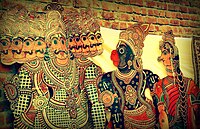
Tholu bommalata is a form of puppetry which originated in the Indian state of Andhra Pradesh. [2] It mainly depicts episodes from the epics. Puppets are large, with a jointed waist, shoulders, elbows, and knees. The classical music of the region influences the music played in the show.
Made of goatskin, a tambourine-like the drum is beaten with sticks creating a rhythm that is softened only by the ankle bells that the 16 to 20 dancers wear. Part of a Telangana custom which sees the Dappu dancers at the front of any procession, whether it be for jatakas, festivals, or marriages, this is truly a celebration of the percussive powers of dance. This lively art form hails from Nizamabad District. The performers wear colorful make-up and even more colorful costumes dance to the musical patterns set by cymbals, tabla and a harmonium. Mythological themes are usually enacted and the audience is rural. It is one of janapada Kalalau.
Popular in Srikakulam and Vizianagaram Districts, this is a devotional dance that invokes the Rain God with its vigor, rhythm, and tempo. Also performed during festivals, the dance sees 15 to 20 vibrant artists with drums around their necks creating mesmerizing beats and heart-stopping acrobatics

Associated with daily tasks harvesting, planting, sowing, etc., the Lambadi is performed by the Banjaras, a semi-nomadic tribe seen all over Andhra Pradesh. Costumes embroidered with glass beads and mirrors, ornate jewelry, ivory bangles, brass anklets, and a natural rhythm make this dance a colorful exposition of joy which is the highlight of many a festive occasion
Dhimsa dance is a dance of young and old, men and women of Valmiki, Bogata, Khond, and Kotia tribes living in the enchanting Araku Valley in the hilly tracts of Vishakhapatnam district. A monthly magazine is published by the name of Dhimsa in [Telugu language] Tribals dance during the months of Chaitra i.e. March and April, on weddings and other festivities. During the festivals dancers of one village visit the other to participate in the dance and join the community feast. Such dances are known as "Sankidi Kelbar". The unique feature of Dhimsa dance is that it canalizes friendship and fraternity between the people of different villages. This being traditionally a tribal dance, the women folk attired in typical tribal dress and ornaments dance in the group to the tune of Mori, Kiridi, Tudumu, Dappu, and Jodukommulu.
Ahimsa had branched off to eight different categories of dances. Boda Dimsa is a worship dance in honor of the village goddess. Men on the right and women on the left form two rows and hold one another firmly in their hands the backs. The first man in the right row with a bunch of peacock feathers in hand in rhythmical steps takes the lead while the last person in the left row joins him. Then all dancers to the sounds of anklets move zigzag in a serpent dance in a circle crying "Hari" and "Hui" return to the rows. In Gundert dims or Usku Dimsa a male dancer while singing sends an invitation to the females to dance with him. Thereafter, the male and female with firm steps move forward and backward stride in a circle. In God Beta Dimsa the dancers bending forward and rising up with a swing go about twenty-five steps and return in the same manner four to five times. Poster-Tola Dimsa dance symbolizes the picking up leaves. Half of the dancers stand side by side in a row, while the rest stand behind the first row in the same manner and keep their hands on shoulders of dancers standing before. Turning their heads to the right and left the two rows march forward and backward. Bhag Dimsa is a dance of art as to how to escape from a tiger's attack. Half of the dancers form a circle holding hand in hand. They stand on their toes, bowing and raising their heads. Moving around swiftly, the rest enter the circle and form a "serpent Coil". This is repeated several times. Natikari Dimsa is a solo dance danced by the Valmikis on the Diwali festival in particular. Kunda Dimsa is a dance where the dancers push each other with their shoulders while swinging rhythmically. Baya Dimsa dance is the dance of a tribal magician when he is possessed by the village goddess. All the villagers with their hands bowed down to imitate the "Ganachari". This continues till the magician returns to normalcy Dimsa dances exhibit community unity without discrimination. These dance forms essentially amplifying their ways of life belong to their cultural heritage. Even though things have changed much, yet the hillmen had retained their traditions unspoiled. Through their dances cannot be included in any classical forms, yet they conform to the rhythm of either "Aditala" or "Rupakatala".
'Kolatam', or the stick dance, is one of the most popular dance narratives in Andhra Pradesh. [3] It is also called Kolannalu or Kolkolannalu. A rural art usually performed during village festivals, kolata kim is a combination of rhythmic movements, songs, and music. It is known as Dandia ras in Gujarat, Garbha in Rajasthan, etc. The Kolatam group comprises dancers in the range of 8 to 40. In kolatam, performed by 8 to 40 artists grouped in pairs, The stick provides the main rhythm. The artists led by the leader move into two circles, the inner circle receiving the strikes while the outer circle delivering them. Kolatam offers a great variety of entertainment to the spectators as well as the participants.
Kolatam is also called Kolanna in the Prakasam district of Andhra Pradesh state. Also dances is Gobbi, Madhuri, Chari, Kumi

Bharatanatyam is an Indian classical dance form that originated in Tamil Nadu. It is one of nine Indian classical dance forms recognized by the Sangeet Natak Akademi, and expresses South Indian religious themes and spiritual ideas, particularly of Shaivism and in general of Hinduism.

Indian classical dance, or Shastriya Nritya, is an umbrella term for different regionally-specific Indian classical dance traditions, rooted in predominantly Hindu musical theatre performance, the theory and practice of which can be traced to the Sanskrit text Natya Shastra. The number of Indian classical dance styles ranges from eight to twelve, or more, depending on the source and scholar; the main organisation for Indian arts preservation, the Sangeet Natak Academy, recognizes eight – Bharatanatyam, Kathak, Kuchipudi, Odissi, Kathakali, Sattriya, Manipuri and Mohiniyattam. Additionally, the Indian Ministry of Culture includes Chhau in its list, recognising nine total styles. Scholars such as Drid Williams add Chhau, Yakshagana and Bhagavata Mela to the list. Each dance tradition originates and comes from a different state and/or region of India; for example, Bharatanatyam is from Tamil Nadu in the south of India, Odissi is from the east coast state of Odisha, and Manipuri is from the northeastern state of Manipur. The music associated with these different dance performances consists many compositions in Hindi, Malayalam, Meitei (Manipuri), Sanskrit, Tamil, Odia, Telugu, and many other Indian-Subcontinent languages; they represent a unity of core ideas, and a diversity of styles, costumes and expression.

Dance in India comprises numerous styles of dances, generally classified as classical or folk. As with other aspects of Indian culture, different forms of dances originated in different parts of India, developed according to the local traditions and also imbibed elements from other parts of the country.
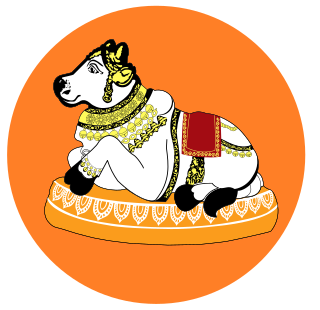
The Jangam or Jangamaru are a Shaiva order of religious monks. They are the priests (Gurus) of the Hindu Shaiva sect, Gurus of Veerashaiva sect and are disciples of Lord Shiva as mentioned in Basava Puranas. The meaning of word Jangam is 'moving linga'. Jangama is one who is endowed with true spirit of Agamic knowledge, and has sacrificed his life for giving Samskara (good) character building practices in all sections of the Hindu society.
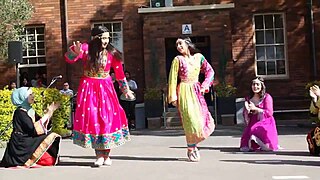
Attan is a traditional dance originating from the tribal Pashtun regions of Afghanistan and Northwestern Pakistan. The dance is performed during weddings or other celebrations. The Attan was also conducted by Pashtuns in times of war such as the British occupation and the Pashtun resistance movement, when Pashtuns used the dance to instil confidence and energy among warriors readying to battle the colonisers. It is now considered the national dance of Afghanistan, popularly carried by other ethnic groups in Afghanistan as well as by the Pashtun ethnic group in Pakistan.

Veerabhadra temple is a Hindu temple located in the Lepakshi, in the state of Andhra Pradesh, India. The temple is dedicated to the Virabhadra, a fierce incarnation of Lord Shiva. Built in the 16th century, the architectural features of the temple are in the Vijayanagara style with profusion of carvings and paintings at almost every exposed surface of the temple. It is one of the centrally protected monuments of national importance and is considered one of the most spectacular Vijayanagara temples. The fresco paintings are particularly detailed in very bright dresses and colours with scenes of Rama and Krishna from the epic stories of the Ramayana, the Mahabharata and the Puranas and they are well preserved. There is a very large Nandi (bull), mount of Shiva, about 200 metres (660 ft) away from the temple which is carved from a single block of stone, which is said to be one of the largest of its type in the world. The temple is home to many Kannada inscriptions as its located close to Karnataka border.

Burra Katha or Burrakatha, is an oral storytelling technique in the Jangam Katha tradition, performed in villages of Andhra Pradesh and Telangana. The troupe consists of one main performer and two co-performers. It is a narrative entertainment that consists of prayers, solo drama, dance, songs, poems and jokes. The topic will be either a Hindu mythological story or a contemporary social issue. It became a popular art form during the Telangana Rebellion in the early 1930-1950's.

Karnataka has a variety of traditional arts, including folk dance and puppetry.

Veeragase/Guggla is a dance form prevalent in the state of Karnataka, India. It is a vigorous dance based on Hindu mythology and involves very intense energy-sapping dance movements performed by Jangama. Veeragase is one of the dances demonstrated in the Dasara procession held in Mysore. This dance is performed during festivals and mainly in the Hindu months of Shravana and Karthika. It is performed at all important functions of Veerashaiva Lingayat household the veeragase artist's are called as puravanta in village side.
The traditional dances of Himachal Pradesh are very complicated. These dances are a vital part of tribal life. It reflects the culture and the tradition of Himachal. Hardly any festivity there is celebrated without dancing. Dance forms such as Nati are performed all over the region.
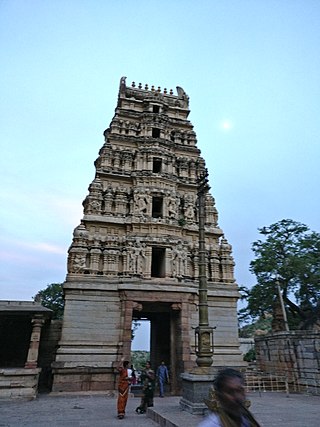
Yaganti Temple or Sri Yaganti Uma Maheswara Temple is a temple of Shiva in Nandyal district in the India state of Andhra Pradesh. It was built according to Vaishnavaite traditions.
Tamil Nadu has a rich history of art and entertainment. The three modes of entertainment classified as Iyel (Literature), Isai (Music) and Nadagam (Drama) had their roots in the rural folk theatre like Theru Koothu. Many forms of group and individual dances with the classical forms for popularity and sheer entertainment value. Some of the dance forms are performed by Tribal people. The majority of these dances are still thriving in Tamil Nadu today.

The culture of Andhra Pradesh embodies some very exclusive and special entities.
Veeranatyam or Dance of the brave is an ancient form of dance from the state of Andhra Pradesh, with associated religious significance.
Nataraja Ramakrishna was an Indian dance guru. He was the chairman of Andhra Pradesh Sangeeta Nataka Academy. He was also a scholar and musicologist who promoted classical dance in Andhra Pradesh and worldwide.

The taal, manjira, jalra, karatala, kartal or gini is a pair of clash cymbals, originating in the Indian subcontinent, which make high-pitched percussion sounds. In its simplest form, it consists of a pair of small hand cymbals. The word taal comes from the Sanskrit word Tālà, which literally means a clap. It is a part of Indian music and culture, used in various traditional customs e.g. Bihu music, Harinaam etc. It is a type of Ghana vadya.

Folk dances of Assam include the Bihu and the Bagurumba, the Bhortal, the Ojapali dance. Assam is home to many groups: Muslim, Indo-Aryan, Rabha, Bodo, Dimasa, Karbi, Mising, Sonowal Kacharis, Mishmi and Tiwa (Lalung) etc. These cultures come together to create an Assamese culture. Residents of the state of Assam are known as "Axomiya" (Assamese). Most tribes have their own language, although Assamese is the primary language of the state.
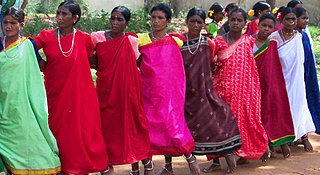
Dhimsa is a tribal dance form that is performed primarily by Porja caste women in Andhra Pradesh .
Veerabhadra Temple is located on Devakuta Parvatham, a hillock on an islet amidst the Godavari River near Pattiseema in West Godavari, Andhra Pradesh. The temple is dedicated to Shiva and the namesake is Veerabhadra.